|
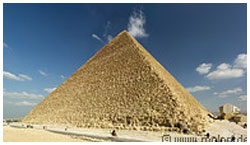 |
 |
1- Pharaonic Cairo: |
| The Great Pyramids: "One of the Seven Wonders of the World, King Cheops' pyramid was built c. 2650 BC "" it is impossible to get tired of the Pyramids." Saqqara: The royal burial-ground during the Old Kingdom (2705-2155 BC). |
| |
|
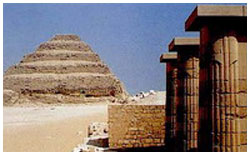 |
There are so many periods represented that Saqqara could almost be a book, in whose pages the story of Egyptian Civilization through the Pharaonic Greek and Roman periods is told. Discoveries are still being made today.
Memphis: One of the oldest cities on earth, legendary Memphis was the capital of ancient Egypt throughout the Old Kingdom. The Mastabas of Mereruka, Ti and Path-Hotep: Carved and painted tombs vividly illustrate everyday life more than 5,000 years ago.
The Step Pyramid: The first proper pyramid, built for King Zoser in the 27th-century BC by the architect Imhotep. |
| |
|
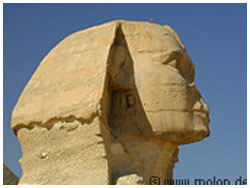 |
The Sphinx: "Sacred symbol of the union of the strongest physical with the highest intellectual power on earth," The Solar Barque of King Cheop: a cedar-wood craft built to take the Pharaoh through the underworld. |
| |
Top |
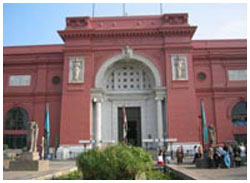 |
The Egyptian Museum: One of the world's most famous museums. The magnificent collection of antiques includes mummies, Sarcophagi and the fabulous treasures from Tutankhamun's tomb. |
 |
 |
|
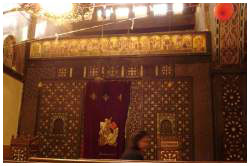 |
|
2- Coptic Cairo: |
| The Hanging Church (Al-Mu'allaqua): Originating in the 4th century, the hanging Church was built over the southern gate of the fortress of Babylon. Dedicated to the Virgin Mary, its treasures include a 14th-century wall painting of the Nativity. Church of St. Sergius and St. Bacchus: A 5th-century basilica, built over a crypt where the Holy family is believed to have stayed during their flight into Egypt. |
| |
|
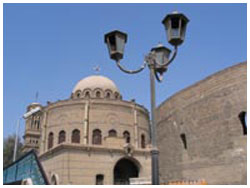 |
Church of St. Mercurius: (Ahi, Sefein): A unique collection of Coptic art including 175 icons representing scenes from the Old and New Testaments wall paintings, etchings and stained glass. The Convent of St. George (Plad Girgis): In the oldest part of Cairo, the chapel is reached through a ratimid hallway and contains the relics of St. George in a cedar wood casket. |
| |
Top |
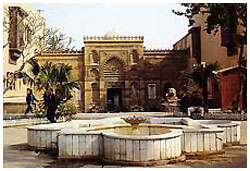 |
The Coptic Museum: It contains a collection of rare antiquities from one of the earliest Christian communities in the world. It holds a collection of valuable pieces of architechetures, Knit artifacts, icons, and old manuscripts. It is also offers the most exentensive collection of Coptic artifacts in the world |
 |
 |
|
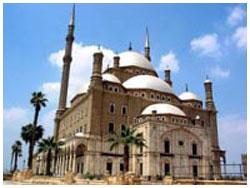 |
|
3-Islamic Cairo: |
| The Citadel of Salah Al-Din: |
Built between 1176 and 1182 AD, the Citadel fortress provides a panoramic view of Cairo from the Moqattam Hills. "...The living world spread out close beneath one's feet. " The Citadel complex includes the Alabaster Mosque
The Mosque and Madrassa of Sultan Hassan:
A masterpiece of Mamluke architecture it includes bronze doors inlaid with gold and silver, marble paneling, and a fountain that used to run with sherbet on special occasions. |
| |
|
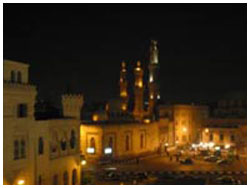 |
A1-Azhar mosque: |
| The first Fatimid mosque arid the oldest Islamic University in the world, founded in 970 AD.
The Qalawun. A1-Nasir Barquq complex:
A medieval complex of mosques, mausoleums and madrassas built by three Mamluke sultans. |
| |
Top |
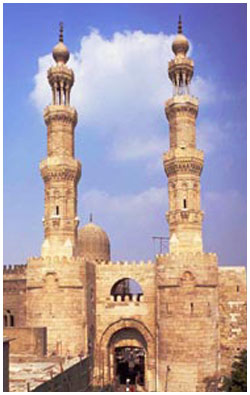 |
Bab Zuwayla: |
Part of the city's fortifications, the gate dates from 1092 AD and was formerly a place of public execution, crowned by the heads of criminals on spikes. Minarets were added to the towers in the fifteenth century.
The Blue Mosque (Mosque of Aqsunqur): Famous for the indigo and turquoise tiles that decorate the interior.
The Mosque of Ibn Tulun: Built between 876 and 879 AD in the classical courtyard style this is Cairo's oldest, intact mosque, still in use today.
Gayer Anderson House: the Ottoman-style residence of an eccentric British major restored and furnished in period style and filled with his collection of Islamic art.
The Islamic Museum: Includes works of art from all over the Islamic world, ranging from large architectural pieces rescued from mosques to ceramics, manuscripts and tapestries |
 |
 |
|
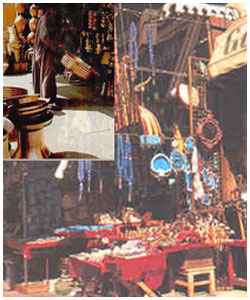 |
|
4- Shopping: |
Cairo offers an incredible selection of shopping, leisure, culture and nightlife. Shopping ranges from the famous Khan El-Khalili Souk, largely unchanged since the 14th century, to modern air-conditioned centers displaying the latest fashions.
All the bounty of the East is here particularly good buys are spices, perfumes, gold and silver, carpets, brass and copperware, leatherwork, glass, ceramics and mashrablya. Try some of the famous street markets, like Wekalet Al-Balah, for fabrics, including Egyptian cotton, the Tentmakers' Bazaar for appliquZ-work, Mohammed Ali Street for musical instruments. When you need a rest take a trip on the Nile in a felucca or ride on horseback from the Giza Pyramids to Saqqara. |
Top |







